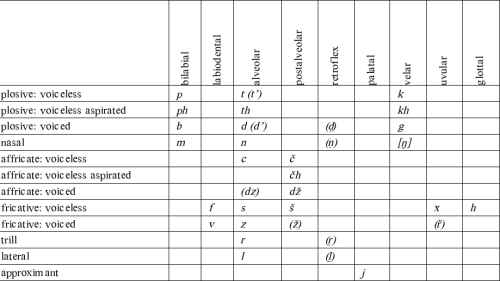The structure of Romani
Sound system
ER consonant phonemes preserved the distinctive aspiration in voiceless stops, which was inherited from the northwest Indic ancestor language, and quite possibly also one or several (possibly allophonic) retroflex consonants. It is likely that some of the Middle Indo-Aryan retroflex sounds had already shifted before the ER period, but at least a number of sounds, notably /ḍ/ as in /*ḍom/ > řom, lom ‘Rom’, /ṇḍ/ as in /*maṇḍa/ > manřo, mando, manlo ‘bread’ and /ṭṭ/ as in /*aṭṭa/ > ařo ‘flour’ appear to have survived well into the ER period. The variation in their continuation in present-day dialects might possibly suggest a set of retroflex variants, for which in turn the dialects each selected one non-retroflex counterpart, normally /ř/ [ʀ, r:], /r/, /n/, /d/ or /l/. In addition to consonants that were retained from the Indo-Aryan inventory, ER also had phonemes that had entered the language with Iranian and later with Greek borrowings: /v/, /f/, /z/, /c/ and possibly also /dz/ and /ž/. There appears to have been allophonic palatalisation of dental stops, and perhaps also of velars, before /i/, as word-specific palatalisation and affrication patterns are often found in the individual dialects (cf. tikno ‘small’ > cikno, keti ‘how much’ > keci, and more).
Figure 1: Early Romani consonant phonemes

Other typical developments in the consonant inventory of the dialects following the ER period include palatalisation around jotated segments (e.g. /dj/ > /d’ ď dź dž dz/), aspiration of /s/ > /h/ in grammatical inflections (in all likelihood inherited in some cases from MIA, then expanded), loss of final /s/, reductions of initial /a/, and prothesis of /j/, /v/ and sometimes other consonants, as well as prothesis of /a/.
The ER vowel system appears to have merged with that of (late) Greek, giving a five-vowel system /i e a o u/, with no opposition of length. Following the ER period, individual dialects have modified the vowel system. Later developments include the addition of the central vowels /ə/ and/or /y/, forward shift of stress (e.g. čhavó ‘child’ > čhávo), and the introduction of vowel length in some dialects (e.g. čhāvo).

